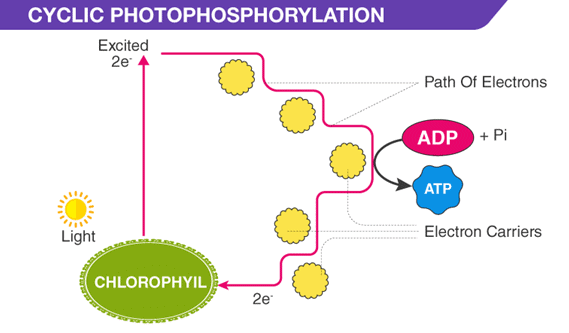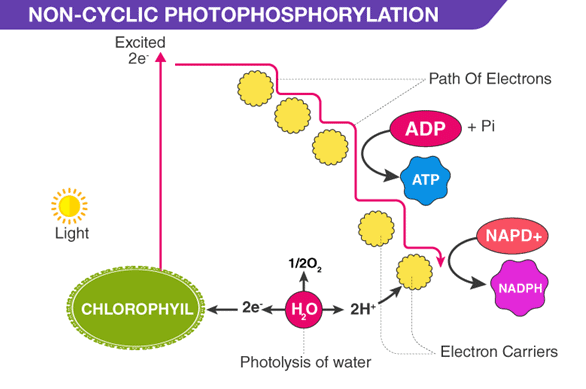Light Reactions & Electron Transport | Biology Class 11 - NEET PDF Download
Mechanism of Photosynthesis
Light Reaction/Hill Reaction/Photochemical Reaction/Generation of Assimilatory Powers (NADPH2 + ATPs)/Photophase
Antenna or accessory pigments receive radient energy and transfer it among themselves. This transfer of energy is known as resonance transfer. Then antenna molecules excited and transfer their energy to the chlorophyll 'a' molecules of reaction centre. It is known as inductive resonance. Finally chl. 'a' of leaf center molecules converts the light energy into electrical energy by bringing about electric charge separation.
Cyclic ETS and Photophosphorylation
In cyclic ETS, only PS–I (LHC–I) works, which consists of Chl–'a' 670, Chl–a–683, Chl–'a'–695, carotenoids, some molecules of chl–'b' & reaction centre–Chl–'a'–700/P–700.
Cyclic ETS OR PS–I is activated by wavelength of light greater than 680 nm.
It occurs at grana thylakoids and stroma thylakoids.
During Cyclic ETS the electron ejected from reaction centre of PS-I, returns back to its reaction centre.
In cyclic ETS, no oxygen evolution occurs, because photolysis of water is absent.
NADPH2 (reducing power) is not formed in cyclic process.
Plastocyanin (PC) is Cu–containing blue coloured protein in cyclic ETS.
According to modern researches, first e– acceptor is FRS (Ferredoxin Reducing Substance), which is a Fe-S containing Protein. Earlier fd (Ferredoxin) was considerd as first e– acceptor.
Phosphorylation takes place at two places, thus two ATP generates in each cyclic ETS
Z-Scheme/Non- Cyclic ETS and Photophosphorylation
Both PS–I and PS–II involved in non cyclic ETS.
PS–II (P–680) consists of Chl–a–660, Chl–a–673, Chl–a–680, Chl–a–690, Chl–b, or Chl–c or Chl–d, carotenoids & phycobilins. Phycobilins present only in PS II
It occurs at grana thylakoids only.
The e– ejected from PS–II never back to chl–a–680 (reaction centre) & finally gained by NADP. Thus gap of e– in PS–II is filled by photolysis of water as a result, oxygen evolution occurs in Z–scheme.
Each turn of non cyclic ETS produces 1 ATP and 2NADPH2 (4 mol. of water is photolysed and 1 O2 released)
Non cyclic Photophosphorylation/Z-scheme
12 NADPH2 + 18 ATP are required as assimilatory power to produce one molecule of Glucose in dark reaction, thus6 turns of Z–scheme are necessary for the production of one glucose molecule by calvin cycle.
Additional 12 ATP come from 6 turn of cyclic ETS. (over all 54 ATP equivalents)
Primary e– acceptor in non–cyclic reaction is PQ or plastoquinone. Recently pheophytin (structure like chl. a without Mg) is considered as Ist e– acceptor in Z–scheme.
Plastocyanin (PC) is link between PS–I and PS–II in non cyclic ETS. (Some scientists–cyto-f)
Final e– acceptor in Z–scheme is NADP+ (Hill reagent)
During Non-Cyclic ETS energy flow takes place from PS II to PS I.
Photophosphorylation
Chemiosmotic Hypothesis: Proposed by Peter Mitchell. During ETC of photosynthesis concentration of H+ gradually increases in thylakoid lumen. During cyclic photphosphrylation PQ leads to shifting of H+ from stroma to thylakoid lumen. On the other hand during non cyclic photophoshorylation threre are three causes of differential H+ ion concentration.
(i) Photolysis of H2O produces H+
(ii) PQ shifting of H+ ion from stroma to lumen.
(iii) NADP redutase mediated utilisation of H+ from stroma.
This differential H+ ion concentration leads to development of proton gradient and electrical potential across thylakoid memberane. Both proton gradient and electrical potential collectively called proton motive force (PMF) *
PMF do not allow stay of H+ ions in lumen so H+ start to move towards stroma through CF0 particle selectively. The passage of 3H+ ions leads to activation of ATP synthase and forms ATP from ADP and Pi.
Some physiologist beleive that synthesis of one ATP is required passage of 2H+ ions.
Dark Reaction/Blackman Reaction/Calvin cycle/C3–Cycle/Biochemical phase/ Carbon Assimilation/Photosynthetic Carbon Reduction Cycle (PCR-Cycle)/Reductive Pentose Phosphates Pathway
Blackman reaction is called as dark reaction, because no direct light is required for this. Calvin presented these reactions in cyclic manner & thus called as Calvin cycle.
Ist stable compound of Calvin cycle is 3C–PGA (Phosphoglyceric acid) thus Calvin cycle is called as C3–cycle. (First compound is unstable, 6C keto acid)
Study by Calvin was on Chlorella & Scenedesmus. During his experiment he used chromatography & radioisotopy (C14) techniques for detecting reactions of C3–cycle.
Rubisco (Ribulose bis-phosphate carboxylase-oxygenase) is main enzyme in C3–cycle, which is present in stroma & it makes 16% protein of chloroplast. Rubisco is most abundant enzyme.
CO2–acceptor in Calvin cycle is RuBp. This carboxylation reaction is catalysed by Rubisco.
C3, C4, C5, C6 and C7 monosaccharides are intermediates of calvin Cycle.
C3 = Phosphoglyceraldehyde and DHAP, C4=Erythrose, C5=Xylulose, Ribose, C, = Sedoheptulose.
The largest monosaccharide in livings are 7C–Sedoheptulose–P (Ketose)
Warburg effect – Inhibitory effect of high conc. of O2 on photosynthesis is called as Warburg effect (It is due to Photorespiration).
6 turns of Calvin cycle are required for the formation of one glucose.
Cyclic And Non Cyclic Photophosphorylation
We all are well aware of the complete process of photosynthesis. Yes, it is the biological process of converting light energy into chemical energy. In this process, light energy is captured and used for converting carbon dioxide and water into glucose and oxygen gas.- Light reaction: The light reaction takes place in the grana of the chloroplast. Here, light energy gets converted to chemical energy as ATP and NADPH. In this very light reaction, the addition of phosphate in the presence of light or the synthesizing of ATP by cells is known as photophosphorylation.
- Dark reaction: While in the dark reaction, the energy produced previously in the light reaction is utilized to fix carbon dioxide into carbohydrates. The location where this happens is the stroma of the chloroplasts.
Photophosphorylation
Photophosphorylation is the process of utilizing light energy from photosynthesis to convert ADP to ATP. It is the process of synthesizing energy-rich ATP molecules by transferring the phosphate group into ADP molecule in the presence of light.- Cyclic Photophosphorylation
- Non-cyclic Photophosphorylation
1. Cyclic Photophosphorylation

The photophosphorylation process which results in the movement of the electrons in a cyclic manner for synthesizing ATP molecules is called cyclic photophosphorylation.In this process, plant cells just accomplish the ADP to ATP for immediate energy for the cells. This process usually takes place in the thylakoid membrane and uses Photosystem I and the chlorophyll P700.
During cyclic photophosphorylation, the electrons are transferred back to P700 instead of moving into the NADP from the electron acceptor. This downward movement of electrons from an acceptor to P700 results in the formation of ATP molecules.
2. Non-Cyclic Photophosphorylation

The photophosphorylation process which results in the movement of the electrons in a non-cyclic manner for synthesizing ATP molecules using the energy from excited electrons provided by photosystem II is called non-cyclic photophosphorylation.This process is referred to as non- cyclic photophosphorylation because the lost electrons by P680 of Photosystem II are occupied by P700 of Photosystem I and are not reverted to P680. Here the complete movement of the electrons is in a unidirectional or in a non- cyclic manner.
During non-cyclic photophosphorylation, the electrons released by P700 are carried by primary acceptor and are finally passed on to NADP. Here, the electrons combine with the protons – H+ which is produced by splitting up of the water molecule and reduces NADP to NADPH2.
Difference between Cyclic and Non-Cyclic Photophosphorylation
Following are the important difference between cyclic and non-cyclic photophosphorylation:
|
150 videos|398 docs|136 tests
|
FAQs on Light Reactions & Electron Transport - Biology Class 11 - NEET
| 1. What is the purpose of light reactions in photosynthesis? |  |
| 2. How does the electron transport chain work in light reactions? |  |
| 3. What are the main components involved in light reactions? |  |
| 4. How does the production of ATP occur during light reactions? |  |
| 5. Can light reactions occur in the absence of sunlight? |  |

















